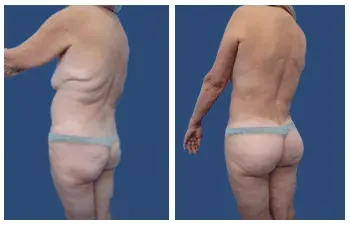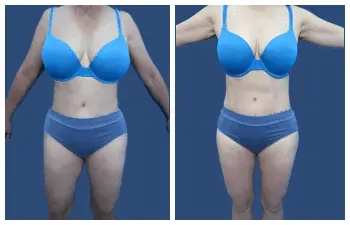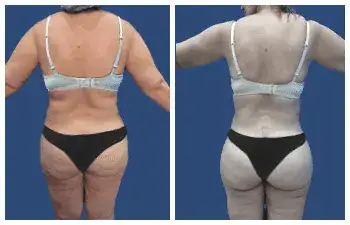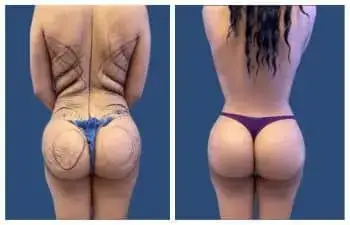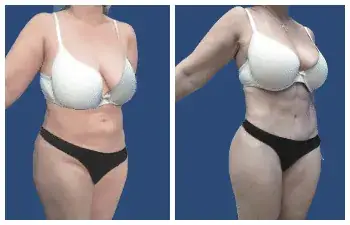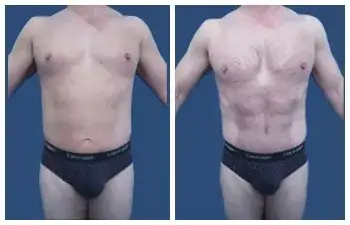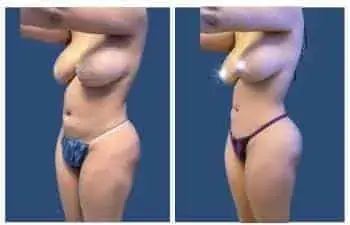Abdominoplasty (tummy tuck) and liposuction are two procedures that are designed to help you lose stubborn body fat and attain a flatter belly. But which one is right for you? tummy tuck vs liposuction?
We are always told that diet and exercise is the best way to lose fat and get the flattest stomach possible. Yet, for some people, no matter how much they watch what they eat or move their bodies, the stubborn pockets of fat never seem to budge, and the scale doesn’t seem to register any fat loss at all.
The reason diet and exercise don’t work for some could be down to genetics, metabolism changes following pregnancy, and previous obesity. For these individuals, body contouring surgery may be the only option left to help them obtain the results they desire. This is where the tummy tuck and liposuction come into play.
What is a Tummy Tuck?
A tummy tuck or abdominoplasty is a surgical procedure that can help remove excess skin from the abdomen. Excess skin often becomes a problem after pregnancy or earlier weight loss and can’t be fixed with mere dietary and exercise habits.
There are two essential types of tummy tuck – partial and full. Both procedures are performed under general anesthetic. Both surgical techniques remove excess fat and sagging skin while tightening the abdominal muscles. In addition, stretch marks and old scarred areas may also be removed along with the sagging skin.
The tummy tuck operation can take several hours. Most often, you can expect to remain in the hospital for days afterward. You can also expect to undergo several weeks of healing before returning to your full daily activities. You may be bruised and swollen for some time, but these side effects will subside with time so that you can enjoy the full benefits offered by the procedure.

What is Liposuction?
Liposuction is another surgical procedure designed to improve the appearance of the abdomen. During the surgery, small areas of body fat are suctioned out and removed. The surgeon first makes small incisions on the abdomen and breaks up the fat cells before removing them with a suction tube.
Unlike abdominoplasty, liposuction is not used to remove excess skin. Therefore, stretch marks and scarring cannot be removed, nor does the procedure tighten the abdominal muscles. It only removes the fat.
Liposuction tends to work best for people who already have tightened abdominal muscles and supple skin, and who are already at a normal weight.
Like the tummy tuck, liposuction is usually performed under general anesthetic, though epidural anesthesia is also an option. If only a small area is being worked on, local anesthesia will generally suffice. The surgery is typically completed in under an hour.
When opting for liposuction, you may have to stay in the hospital for a night following the operation. The total recovery time tends to be as little as two to six weeks.
Keep in mind that liposuction isn’t just confined to the abdomen, as it can be performed on other parts of the body as well, such as the arms, hips, and thighs.
Which is Better: Tummy Tuck vs Liposuction?
Both the tummy tuck and liposuction can help patients achieve their body contouring goals. When it comes to which procedure is right for you, it all depends on the goals you hold to be most important.
The tummy tuck is ideal if you have a body mass index of over 30, you are considering getting pregnant in the future, and if you are actively trying to lose weight.
Your surgeon may also recommend a tummy tuck over liposuction if you have a chronic heart condition.
Liposuction is the best fit if you are only looking to remove small deposits of fat that are most commonly found on the hips, thighs, buttocks, and stomach areas. The procedure removes fat deposits from the targeted area, which reduces bulges and improves the body’s contour.
Another thing to keep in mind about liposuction is that the procedure is not recommended as a weight loss tool. As in, you shouldn’t get liposuction if you are obese.
How Much Do the Tummy Tuck and Liposuction Procedures Cost?
The average cost of a tummy tuck is around $5,798 while liposuction costs $3,200.
Do You Lose Weight After a Tummy Tuck?
A tummy tuck is designed to flatten the tummy and tighten the abdominal muscles but should not be used for weight loss. You should, however, plan to change your lifestyle following surgery, which includes a high protein diet and exercise. Doing so will help you maintain the results you gain for the long-term.
For best results, you should be as close as possible to your ideal weight before opting for the tummy tuck procedure.
How Painful is a Tummy Tuck?
The tummy tuck procedure itself is not painful, as you will be under anesthesia as the surgery happens. Afterward, you may feel slight discomfort in the abdomen, particularly if you also had the ab muscles tightened.
If your surgeon placed a drainage tube around the surgery site, you may experience discomfort around this area. The tube is usually left in for about a week after surgery. The soreness around this area is normal but swelling and bleeding are not. Contact your surgeon if you notice blood or swelling around the drainage tube.
The most intense discomfort typically comes right after surgery and will subside within about a week. You should plan on resting during this time. After the first week, you should begin to notice a decrease in discomfort around the surgical site, though you may still feel sore or tight for a few more weeks.
You may also feel some soreness when engaging in your everyday activities, like getting out of bed and standing up straight. This is completely normal. Your body will adjust and react to your smaller tummy area in no time.
If you think the discomfort will be too much for you, your surgeon may recommend a “mini” tummy tuck. This procedure removes excess skin and fat from the lower abdominal area with no drainage tube, minimal pain levels, and less downtime.
How Long Does a Tummy Tuck Last?
The surgery itself takes around two to six hours, depending on the extent of the procedure being performed. For instance, if you are just having your tummy flattened, you can expect the procedure to be shorter than it would be if you also had your abdominal muscles tightened.
Healing generally takes the longest when opting for a tummy tuck. In addition to healing time, when you should allow your body to rest, you can expect full healing to take about a year’s time.
Does the Fat Come Back after Lipo?
Many patients want to know if liposuction permanently removes fat. The answer is yes, liposuctions out fat cells so that they are no longer in your body. However, it is possible for fat to return after lipo, but only if you allow it to come back.
The fact is that patients who succeed in maintaining their “post-liposuction weight” tend to experience the most dramatic results. For these patients, the fat will not return, and the ideal results will remain intact.
Who is a Good Candidate for Liposuction?
The best candidates for liposuction include adults who are within 30% of their ideal weight and who have firm, elastic skin along with good muscle tone.
Before your surgeon can recommend lipo, he or she will need to ensure that you are not suffering from a life-threatening illness or medical condition that can impair the healing process. You must also be a non-smoker.
Ideally, you will have a positive outlook and specific goals in mind for body contouring before your surgeon will recommend the procedure for long-term fat loss.
How do I Prepare for a Tummy Tuck?
Your surgeon will likely recommend that you schedule an initial consultation before you can opt for the tummy tuck procedure. During this process, your surgeon will examine you and assess your medical history to determine if you are indeed a good candidate for the procedure. He or she will also give you strict instructions to follow to prepare for the surgery.
Preparation for a tummy tuck can include taking certain medications or adjusting your current medications. If you are a smoker, you will probably be advised to stop smoking. Your surgeon will also tell you not to use aspirin, anti-inflammatory drugs, or herbal supplements, as these can increase bleeding.
In addition, if your tummy tuck is performed on an outpatient basis, you should arrange for someone to drive you to and from surgery. You might want to plan to have that person stay with you for at least the initial night following the surgical procedure.
How Dangerous is a Tummy Tuck?
All surgeries come with risks, but millions of people have undergone the tummy tuck procedure without any significant or lifelong problems.
The risks of tummy tuck include risks of anesthesia, bleeding, and infection, though these are similar risks associated with most surgeries accompanied by anesthesia.
There may be fluid accumulation, also known as seroma, poor wound healing, skin loss, and numbness or other changes to skin sensations. Some patients may experience skin discoloration, prolonged swelling, unfavorable scarring, recurrent looseness of skin, and deep vein thrombosis.
Other risks can include asymmetry, suboptimal aesthetic results, the possibility of revisional surgery, and persistent pain.
Talk with your surgeon about the risks involved with tummy tuck procedures so that you can have a better understanding of what to expect when opting for abdominoplasty.
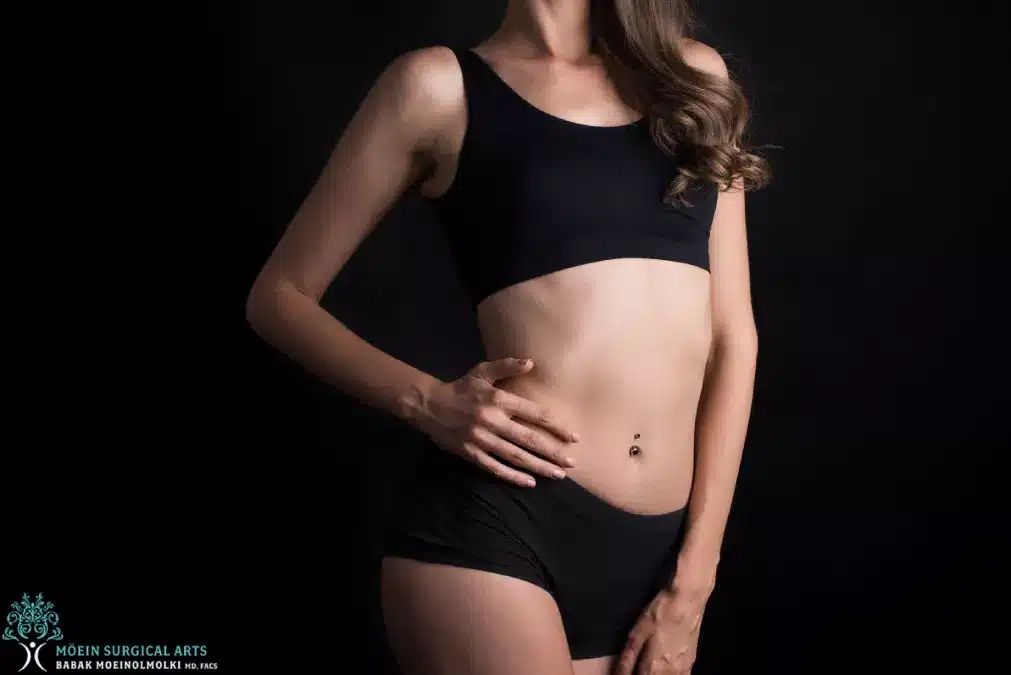
Is Getting a Tummy Tuck Worth It?
Many people have had excellent success with the tummy tuck procedure. Talk to your surgeon about maintaining realistic results when opting for surgery.
Can an Obese Person Have a Tummy Tuck?
Ideally, you should be within ten pounds of your ideal weight when undergoing the tummy tuck procedure.
As such, your surgeon may recommend the body contouring surgery after engaging in a procedure like the gastric sleeve, which can help to bring the weight down to a more manageable level.
How Much Fat Can Lipo Remove?
Surgical guidelines state that a surgeon is only allowed to extract a maximum of 5,000 milliliters of fat from a patient. That comes out to around eleven pounds for all patients, regardless of variations in body weight or body fat status.
How Many Pounds are Removed in a Tummy Tuck?
Once again, the tummy tuck procedure is not intended for weight loss. However, you can expect to lose around 6.6 pounds of unsightly fat and sagging skin. Your results may vary, depending on how much excess fat there is to gather and how much sagging skin there is.
Find Out if a Tummy Tuck or Liposuction Procedure is Right for You
Now that you know more about the tummy tuck procedure and liposuction, it’s time to determine if one or maybe both procedures are right for you. This isn’t a decision to make lightly, nor is it one to make on your own.
To make your decision easier, you should first determine if you are a good candidate for abdominoplasty or lipo. You can do that by scheduling an appointment with an experienced body contouring surgeon like Dr. Moeinolmolki at Moein Surgical Arts.
If you have a high BMI, Dr. Moein may recommend that you lose weight first before you can opt for surgery. The doctor has scientifically backed processes to help you lose excess weight, which will make the surgical procedures safer while yielding superior results.
An initial consultation with Dr. Moein can help you better understand the differences between these two surgeries and put you on track to help you achieve your body contouring goals.
It is during the consult that you can have your questions answered and learn if the tummy tuck or liposuction is the perfect procedure for your needs and goals.
You can schedule your appointment by calling the friendly staff at Moein Surgical Arts in Los Angeles, California.

